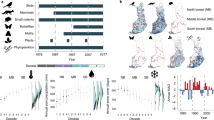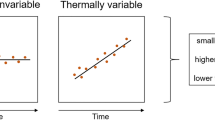Abstract
The steep decline in the number of species from Tropic to Pole may possibly be explained by 'the weather', that is, the latitudinal decline in the input of solar energy. This explanation, often obvious to the lay person, is dismissed or even ignored by most ecologists1–3. Only J. H. Brown and colleagues have proposed a direct 'species–energy' relationship4–6, an excellent scientific theory which implies simple tests that would refute the theory if it failed them. One such is the change in species numbers according to the seasonal fluctuation in the distribution of available energy: we will show that the varying distribution of small insectivorous birds in Britain in summer and winter corresponds well with the predictions of the species–energy theory; it also provides support for the theoretical model which explains it6,7. We find no support for the alternative 'historical' and 'habitat' theories.
This is a preview of subscription content, access via your institution
Access options
Subscribe to this journal
Receive 51 print issues and online access
$199.00 per year
only $3.90 per issue
Buy this article
- Purchase on Springer Link
- Instant access to full article PDF
Prices may be subject to local taxes which are calculated during checkout
Similar content being viewed by others
References
Pianka, E. R. Evolutionary Ecology (Harper and Row, New York, 1974).
Begon, M., Harper, J. L. & Townsend, C. R. Ecology. Individuals, Populations and Com-munities (Blackwell Scientific, Oxford, 1986).
Krebs, C. R. Ecology 2nd edn (Harper and Row, New York, 1978).
Brown, J. H. Am. Zool. 21, 877–888 (1981).
Brown, J. H. & Gibson, A. C. Biogeography (Mosby, St Louis, 1983).
Wright, D. H. Oikos 41, 495–506 (1983).
Turner, J. R. G., Gatehouse, C. M. & Corey, C. A. Oikos 48, 195–203 (1987).
Terentev, P. V. Vest. Leningrad. Univ. Ser. Biol. 18, 19–26 (1963).
Rickerson, P. J. & Lum, K. Am. Nat. 116, 504–536 (1980).
Currie, D. J. & Paquin, V. Nature 329, 326–327 (1987).
Connell, J. H. & Orias, E. Am. Nat. 98, 399–414 (1964).
MacArthur, R. H. Biol. Rev. 40, 510–533 (1965).
Jeffries, M. J. & Lawton, J. H. Biol. J. Linn. Soc. Lond. 23, 269–286 (1984).
Whittaker, R. H. Evol. Biol. 10, 1–67 (1977).
Sharrock, J. T. R. The Atlas of Breeding Birds in Britain and Ireland (British Trust for Ornithology, Irish Wildbird Conservancy, Tring, 1976).
Lack, P. The Atlas of Wintering Birds in Britain and Ireland (Poyser, Calton, 1986).
Meteorological Office Averages of Bright Sunshine for the United Kingdom 1941-70 (HMSO, London, 1976).
Meteorological Office Averages of Temperature for the United Kingdom 1941-70 (HMSO, London, 1976).
Beirne, B. P. The Origin and History of the British Fauna (Methuen, London, 1952).
Harrison Mathews, L. British Mammals (Collins, London, 1952).
Dennis, R. L. H. The British Butterflies. Their Origin and Establishment (Classey, Faringdon, 1977).
Mathews, J. R. Origin and Distribution of the British Flora (Hutchinson, London, 1955).
Godwin, H. The History of the British Flora 2nd edn (Cambridge University Press, 1975).
Anonymous. The Atlas of Breeding Birds in Britain and Ireland. Transparent Overlays of Environmental Factors (British Trust for Ornithology, Tring, n.d. [1976]).
Beven, G. London Nat. 55, 23–42 (1976).
Williamson, M. H. Island Populations (Oxford University Press, 1981).
Ricklefs, R. E. Ecology (Chiron, Newton, 1973).
Newton, I. Finches (Collins, London, 1972).
Elkins, N. Weather and Bird Behaviour (Poyser, Calton, 1983).
Pforr, M. & Limbrunner, A. The Breeding Birds of Europe Vol. 2 (Croom Helm, London, 1982).
Peterson, R., Mountfort, G. & Hollom, P. A. D. A Field Guide to the Birds of Britain and Europe (Collins, London, 1954).
Meteorological Office Averages of Bright Sunshine for Great Britain and Northern Ireland 1931-60 (HMSO, London, 1963).
Meteorological Office Averages of Temperature for Great Britain and Northern Ireland 1931-60 (HMSO, London, 1963).
Meteorological Office Averages of Bright Sunshine for Great Britain and Northern Ireland 1921-50 (HMSO, London, 1953).
Meteorological Office Averages of Temperature for Great Britain and Northern Ireland 1921-50 (HMSO, London, 1953).
Harley, J. B. Ordnance Survey Maps: a Descriptive Manual (Ordnance Survey, Southampton, 1975).
White, E. J. J. appl. Ecol. 10, 1–67 (1979).
Author information
Authors and Affiliations
Rights and permissions
About this article
Cite this article
Turner, J., Lennon, J. & Lawrenson, J. British bird species distributions and the energy theory. Nature 335, 539–541 (1988). https://doi.org/10.1038/335539a0
Received:
Accepted:
Issue Date:
DOI: https://doi.org/10.1038/335539a0
Comments
By submitting a comment you agree to abide by our Terms and Community Guidelines. If you find something abusive or that does not comply with our terms or guidelines please flag it as inappropriate.



